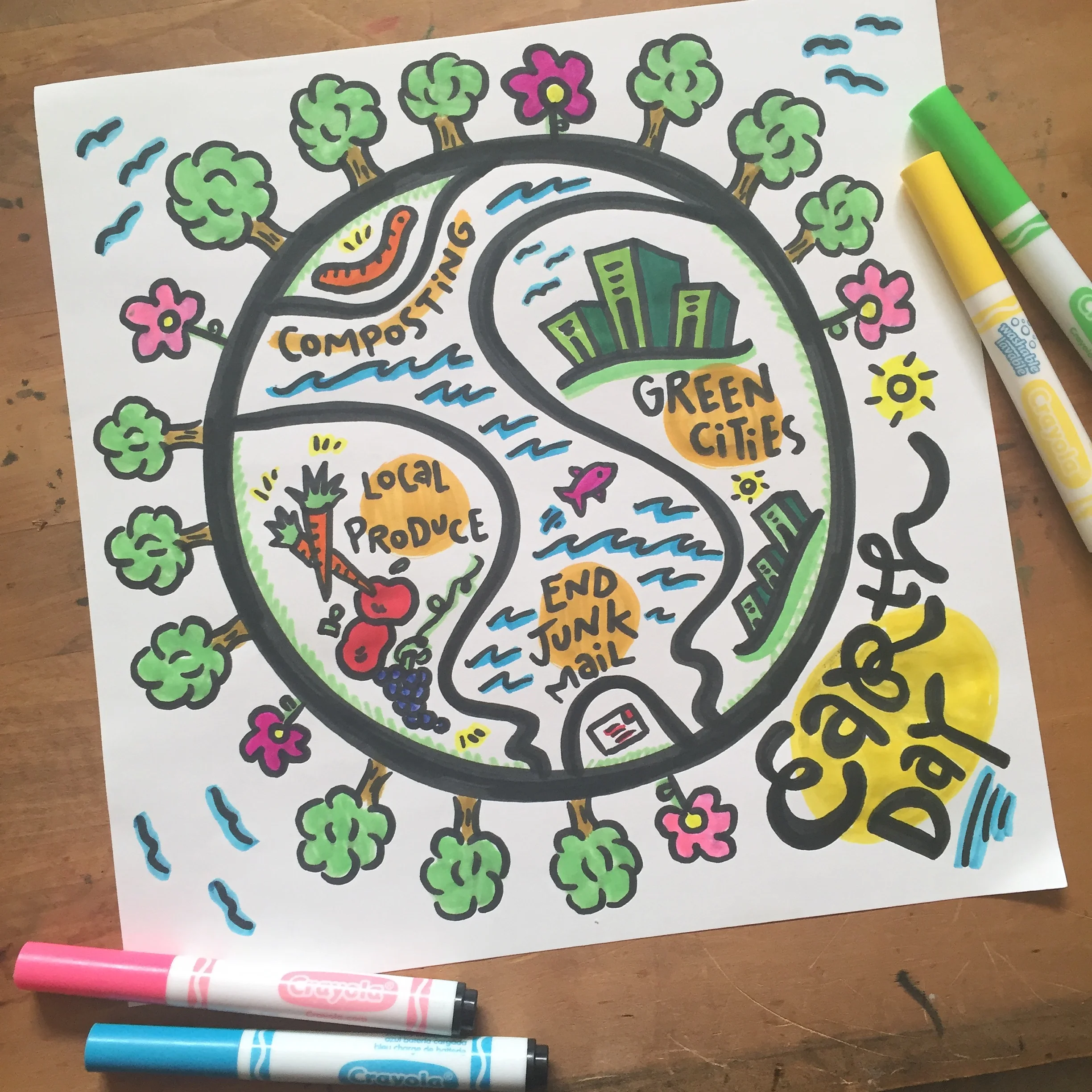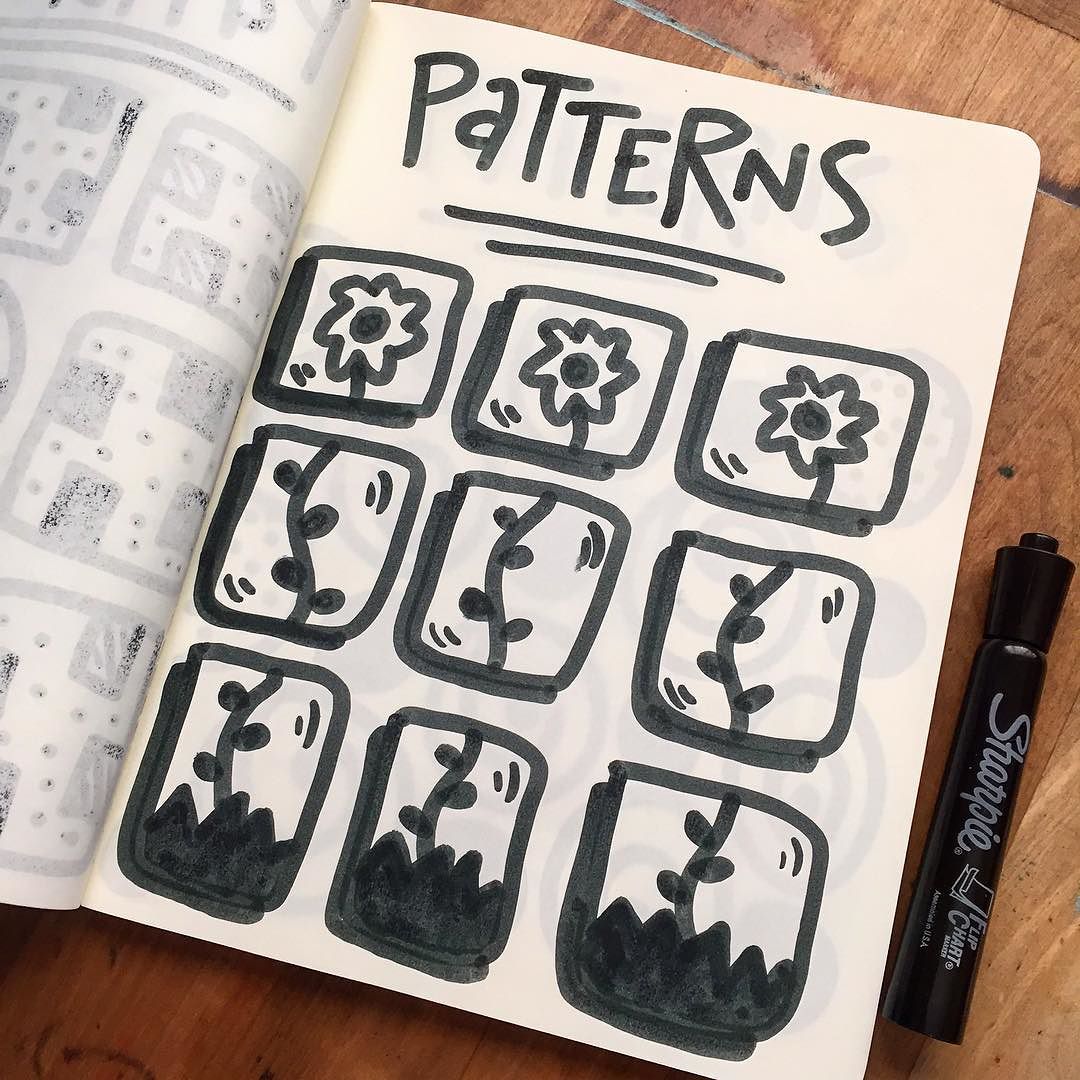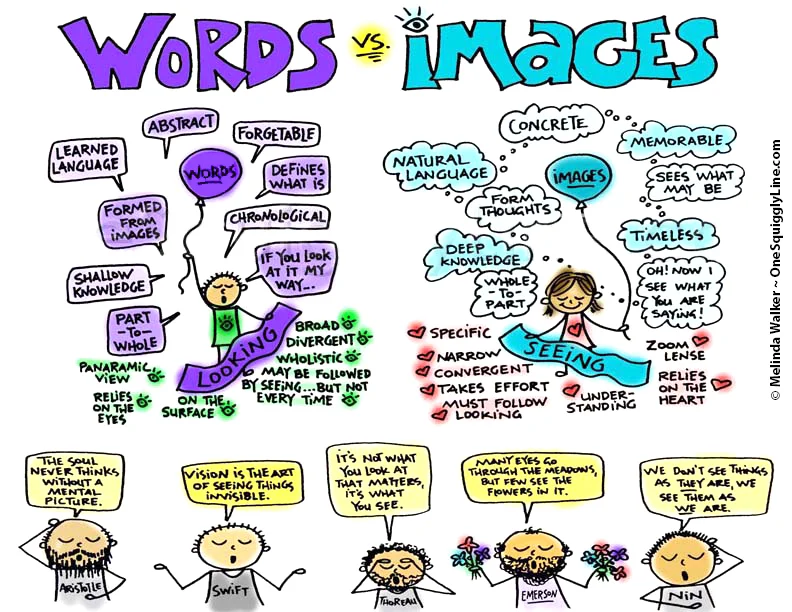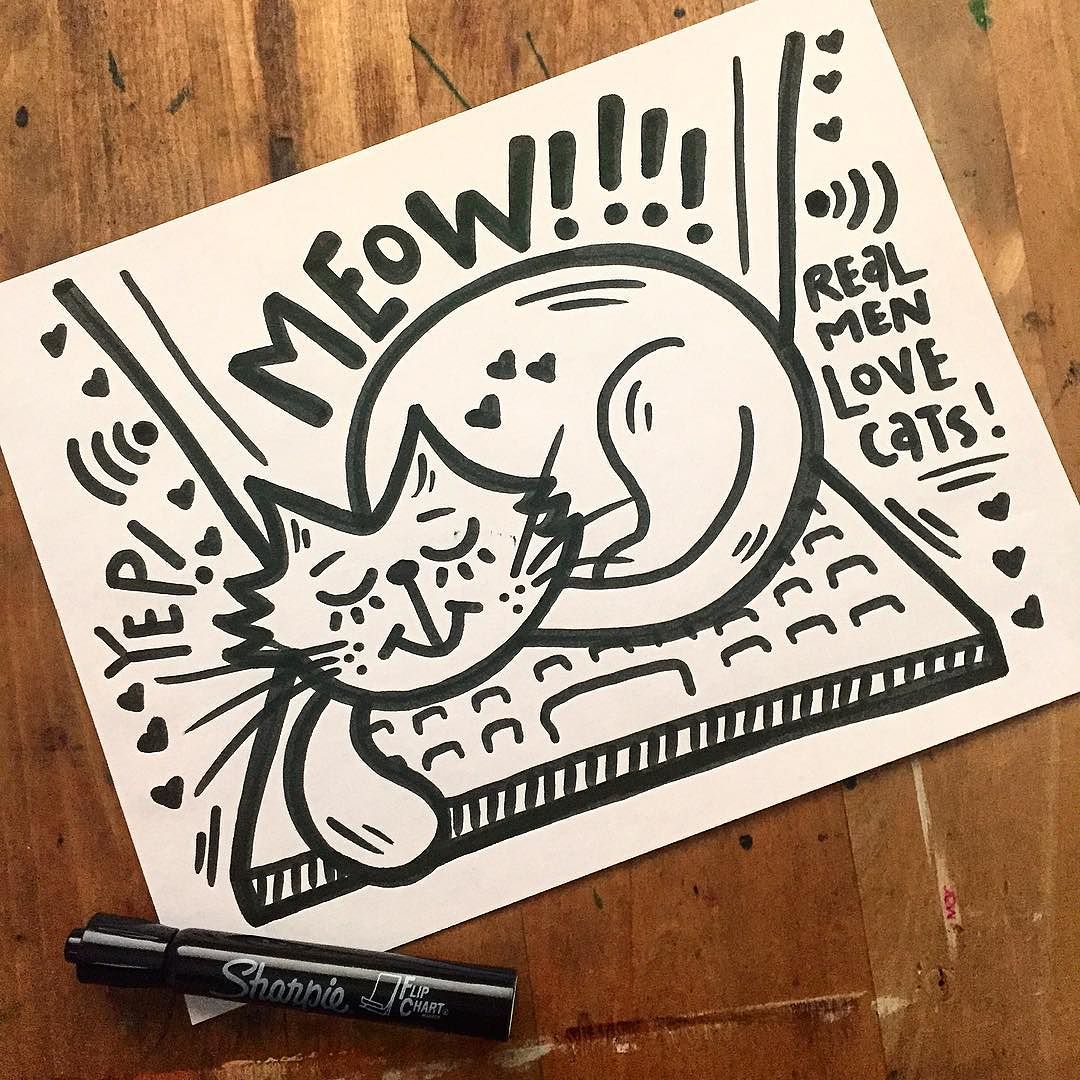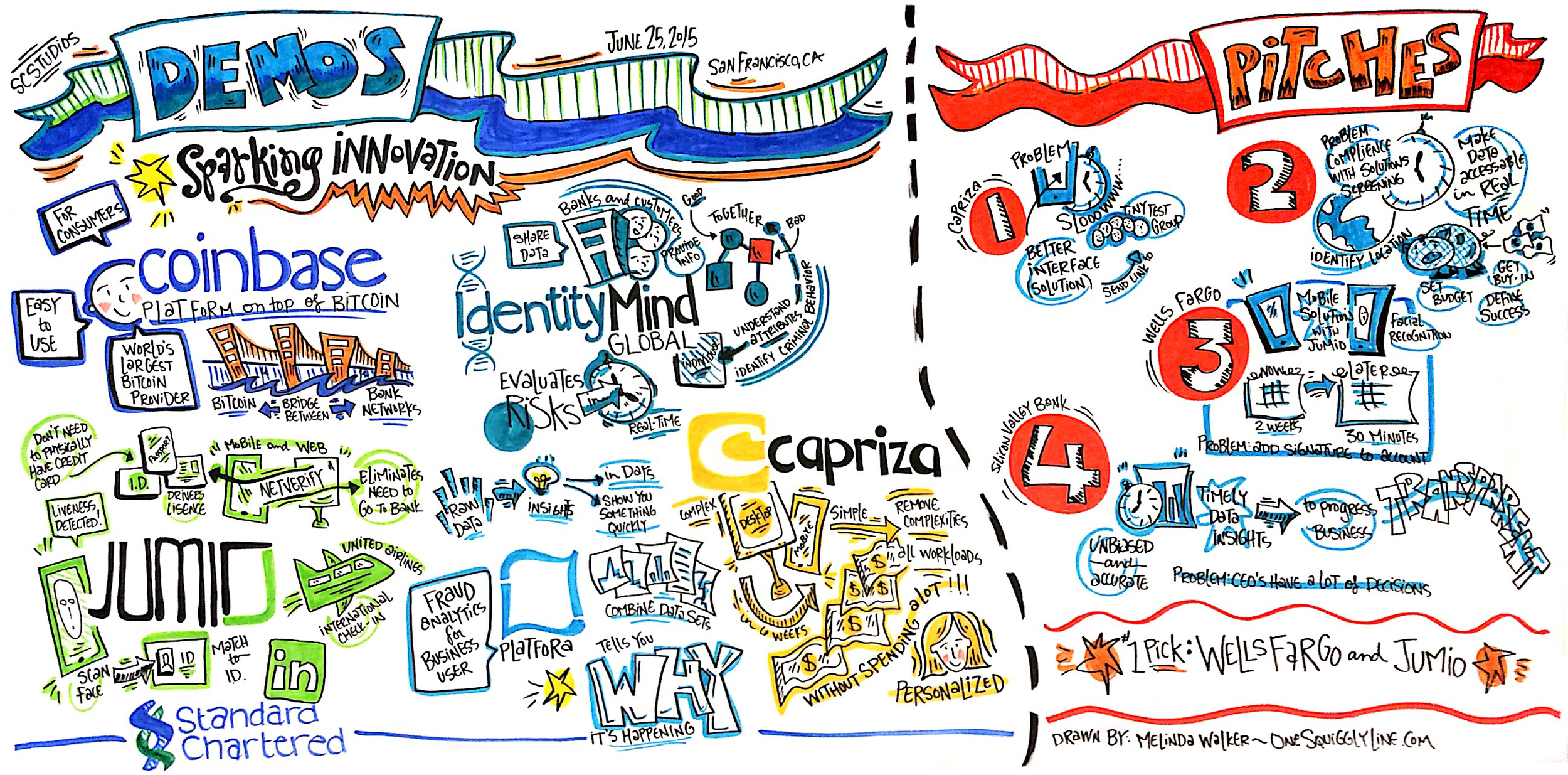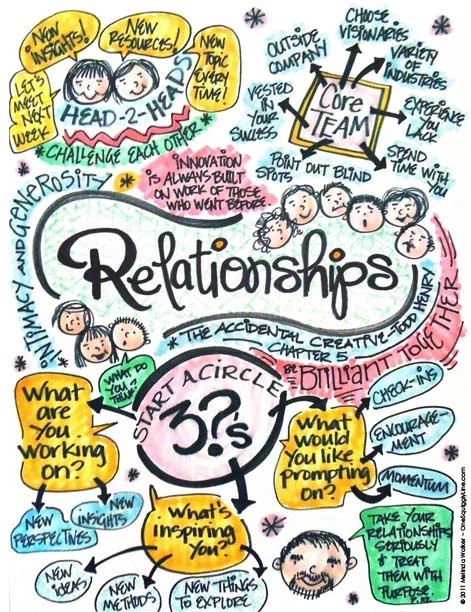Pictures are obviously a big part of visual thinking. So are words. But if you just throw a bunch of words and pictures on a page, you just end up with a mess. A visual mess that makes your thinking messy, too.
That's where organization comes in. It's the third essential component of successful visuals. It doesn't have to be fancy. In fact, it's often best to keep things really simple.
A timeline is a simple and effective way to visually organize information.The image above shows a simple timeline of the International Center for Studies in Creativity, where I got my master's degree. Of course there's a whole lot more to their story than shown in this timeline, but it includes the things that influenced or impacted me in some way. You get the idea, at a glance.
Check out One Squiggly Line's About Visual Thinking page to learn more.
Visual Thinking & Creativity: World Creativity & Innovation Week
It's two months since World Creativity and Innovation Week. But why not celebrate it every month? On April 15-22 every year, people from around the world celebrate creativity and innovation by deliberately doing something creative every day. It could be something simple or something profound. It really doesn't matter — just be creative, whatever month it is!
Visual Thinking & Creativity: Think inside the box, too!
There's a myth out there that highly creative people just sit around and wait for inspiration to strike. Like a great big lightening bolt from the sky. Or a soft whisper from a mystical muse.
Truth is, creativity is not quite so passive. It is an active process. And there's a science to it, not just an art. There are even formulas, methods, and procedures for generating ideas and, equally importantly, evaluating them.
While there's often a push to "think outside the box" when generating ideas, thinking inside the box can be just as important. And productive. "The box" gives you a starting place, and sometimes getting started can be the hardest part.
So when looking for creative ideas, it's really ok to start with what you know, right where you are, with whatever you have right in front of you. Because once you start, you'll most likely keep going until that great idea hits you.
Visual Thinking: Words vs. Images
To many, the term visual thinking means pictures. Lots and lots of pictures. Maybe some charts and diagrams, too. And possibly a few mind maps thrown in for fun.
While pictures are a big part of visual thinking, words are also a big part. Words can be really powerful. Pictures can be very powerful. And when you put the two together, the message becomes even more powerful.
Check out the drawing above to see more specifically what's involved with both words and pictures.
Check out One Squiggly Line's About Visual Thinking page to learn more.
Visual Thinking & Lettering: When Things Go Wrong
Visual Thinking & Creativity: Catnaps
There's a myth out there that highly creative people just sit around and wait for inspiration to strike. Like a great big lightening bolt from the sky. Or a soft whisper from a mystical muse.
Truth is, creativity is not quite so passive. It is an active process. And there's a science to it, not just an art. There are even formulas, methods, and procedures for generating ideas and, equally importantly, evaluating them.
Even so, sometimes all that thinking and evaluating can be quite exhausting. That never leads to great ideas. Or great work. And it can cause you to get stuck.
The best thing to do when that happens is...nothing! Nothing related to whatever you're mulling over, that is. I like to call those little breaks catnaps. You could literally take a little nap. Or go for a walk. Or watch a few fun videos. Or even go do your laundry! It really doesn't matter what you do, as long as it gets your mind off of whatever you were thinking about.
That may sound rather passive, and even look passive, too. But while you're busy snoozing or doing your laundry or whatever, your mind is still hard at work searching for that great idea. And it will not stop until it finds something you're satisfied with.
Visual Thinking & Live Visual Notes (Graphic Recording): Demos & Pitches
Demos and pitches are a pretty common part of the business world. Actually, they're a big part of every world, even if you don't formally use the term "demo" or "pitch". At the heart of both demos and pitches is a quick, concise presentation of key points. Hopefully, that presentation is both entertaining and memorable.
Hand-drawn visuals are a great way to make your presentation more entertaining and memorable. The drawing above was created live, in real-time as the speakers gave their demo or pitch.
To see more examples of visual notes create live, in the moment, visit One Squiggly Line's Live Graphic Recording page. Or for visuals created to highlight key points, created before or after a presentation or from print materials, see One Squiggly Line's Synthesis Images page.
Visual Thinking & Creativity: Smile!
It probably comes as no surprise that cheerful, happy visuals can put you in a cheerier mood. Or make you crack a smile at the very least.
What may come as a surprise is that cheery visuals impact more than mood. And that impact differs between men and women. Men experience a greater drop in anxiety than women do when looking at a happy picture. Women, on the other hand, experience a greater boost in their working memory than men do when faced with a cheerful picture.
Check out One Squiggly Line's About Visual Thinking page to learn more.
Visual Thinking & Leadership: A Strong Vision
A leader is one who sees more than others see, who sees farther than others see, and who sees before others do. — Leroy Eims
Leadership starts with a vision. Whether you're leading a country, a company, or simply yourself, you must have a vision. A strong one. Because the stronger the vision, the more likely success will be.
That vision, strong or not, always begins in your imagination, or the mind's eye. That's where you start to see things as you'd like them to be in the future. Or the way you wish things could be right now.
Getting that vision out of your head and onto paper makes it more concrete. That allows you to see your vision more clearly, to flesh it out, and to better communicate it to others. It also allows you to see what may be missing or what may not be necessary. A tangible drawing makes your thinking and communication much more efficient!
Drawing out your vision and keeping it someplace where everyone can easily see it, keeps your vision front and center in everyone's mind, which fuels the motivation needed to continue moving forward. A physical image also allows everyone to see how far you've already come, hopefully prompting you to celebrate those successes along the way.
So pick up those markers and start drawing! Remember, you're drawing to communicate here, not to create the next Mona Lisa!
Check out One Squiggly Line's About Visual Thinking page to learn more.
Visual Thinking & Visual Notes: Books
People often think of taking visual notes while listening to a live presentation or maybe an audio file. But there's no reason why your notes from print materials can't be visual, too. Especially if you're studying. Or gathering information to write a longer paper. Or even reading a non-fiction book just for fun.
The visual notes above were created while reading chapter 5 of The Accidental Creative, by Todd Henry. One assignment in my grad program was to write a book review. Of course, that meant I had to actually read the book first! So, I created visual notes of each chapter as I went along. That made it much, much easier to see main themes as they emerged.
I had no intention of showing these to anyone when I created them. They were just how I kept track of the key points from each chapter. And I actually ended up "writing" the entire book review visually!
You can see then entire set in this Pinterest board. Because I hadn't planned on sharing them with anyone, I experimented with some things. Some I like better than others, but they all did the job of making my notes much easier to use later on...and the whole project way more fun!


